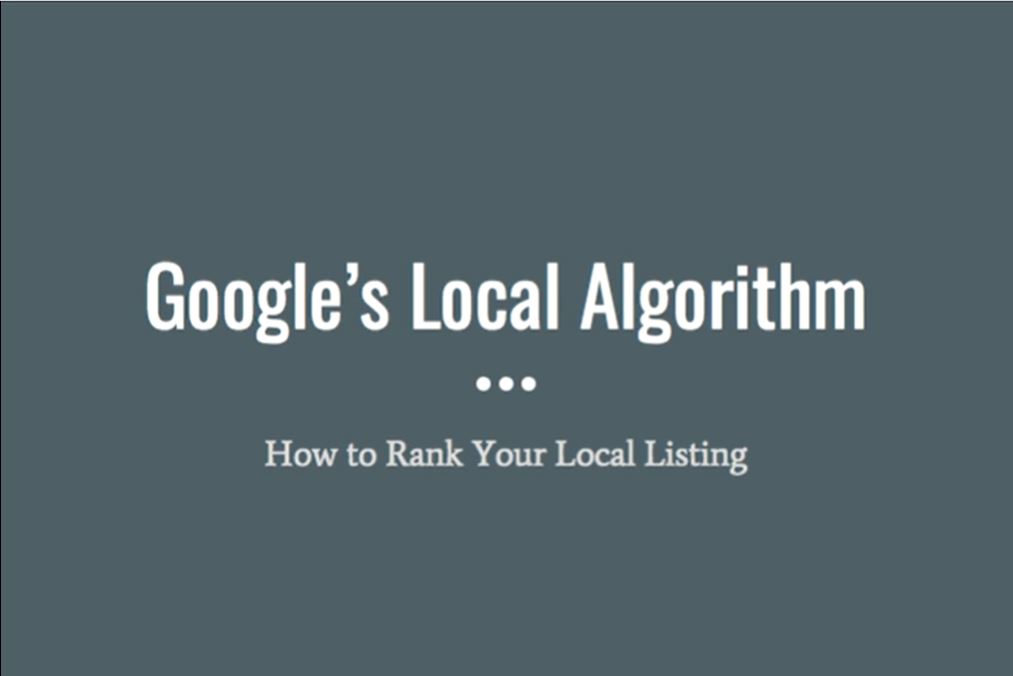
Chad Kimball: Google Maps is a totally different ranking system than other google properties. So lets dive right in to it. I’m writing this with my brother, Seth, who is going to jump in and give a lot of detail on each of the ranking factors, but I just want to give a quick intro and talk about a couple of things. The first thing I want to say is that you’re going to read a lot of news about a lot of different changes. And you might hear about this ranking update or this Google update. But just so you know, the main factors that we talk about in this article, meaning the website, the website that’s connected to the listing and the citations, Seth is going to get into detail about what that exactly is, and the location, and your category, obviously your category, but those three or four things have pretty much consistently been the main ranking signals for a long, long time with some changes here and there. But overall, if you’re hitting those things strongly, you’re going to do well ranking in Google Maps.
The second thing that I want to say before Seth jumps in and gives a lot of detail on these things is that the algorithm for the Local Pack and the algorithm for Google Maps are different. But the main ranking factors that we’re going to give you here apply for both, but sometimes you’re going to need to fight a ranking battle in both fronts, both the Local Pack… When I say Local Pack, I mean, when you just go to regular google.com and you do a local search, like Locksmith Philadelphia, or something like that, and it’s going to bring up a little map with one to three businesses in it right there in the Google Local Search…I mean, right there in the regular Google Organic Search results page. That’s what I mean when I say Local Pack. There’s a one ranking algorithm for what shows up in that pack and the order that they show up. And then the other ranking algorithm is Google Maps, which is if you go to google.com/maps and you do the same search, you’ll see that sometimes the order of businesses changes slightly.
So, sometimes you do have to fight a battle on both fronts. But the ranking factors of the algorithm that we talk about in this article are going to apply for both. It’s just that you want to look at both of those results to figure out who you have to fight and beat in order to win the battle and make sure that you’re ranking both in the Local Pack and in the Map’s results, both. And then the third thing is, with all the factors that we talk about here, it is a good idea to run competitive analysis software and just get the numbers for all these major factors that we’re going to talk about. If you’re trying to beat competitors in the local search game, it’s basically similar to a battle in the regular search results, the non-local search results in that you want to find the main ranking algorithm factors and line all your competitors up, and see which ones have the strongest numbers. In other words, like the highest number of quality citations, or the highest number of quality content pages on your site, or the highest number of backlinks. And you want to beat the people that have the most and that’s what’s going to get you on top. So, we have free software that we offer that does that analysis for you of your competitors. I highly recommend that you do that, as well as read and follow through this article.
And with that, I’m going to let Seth jump in and he’s going to give you the details on each one of the ranking factors in today’s Google’s Local Algorithm. And just one more thing, after Seth goes through all the details of each ranking factor, I’m going to get back on and talk about just some of the cutting edge stuff that we’ve been doing at the end of this article. And some of the stuff isn’t part of the main core algorithm, but it can really give you an edge up on your competition, especially if you’re dealing with a situation where you have beat all your competitors in every other area, but you’re still not ranking or where you want to just solidify your position. And some of the things I’m going to talk about at the end of this article are also shortcuts that can get you ranked very fast. You know, they might be factors that aren’t long-term factors, but they are factors that can give you a short-term advantage if you know what you’re doing. So stay tuned for the end of the article where I’m going to talk about a lot of the cutting edge stuff that we’re doing.
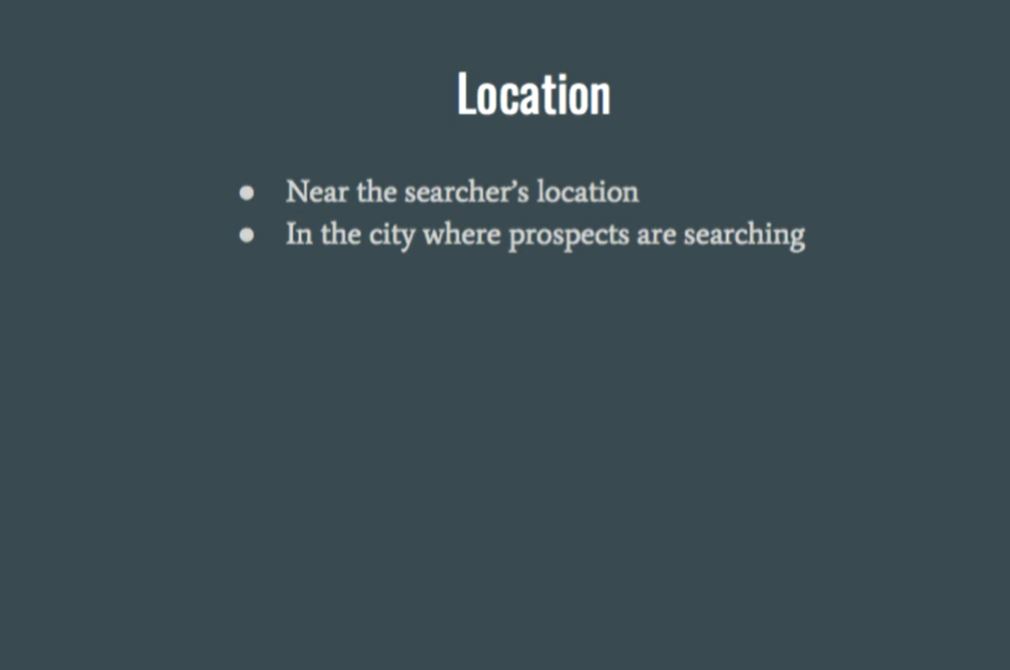
Seth: Thanks, Chad. All right, let’s talk about some of the details of what factors are going to help your listing to rank in Google Maps and also in Google’s Local Pack that appears when local results show up for a regular Google web search. Location is something that you can’t change about your business, at least if you’re working with a white hat listing. But it is something that you’re going to need to bear in mind, especially when you’re doing competition research and thinking about how difficult it’s going to be to rank above your competition. More and more, Google is getting good at knowing where the searcher is when they are searching. And having your location near the searcher’s actual location, so the business address near the actual searcher’s location has become a very large factor. And if the searcher is using a mobile phone, then very often, GPS data is going to tell Google exactly where the searcher is. In the case of a desktop, it’s actually going to be having your business address near where Google thinks the searcher is.
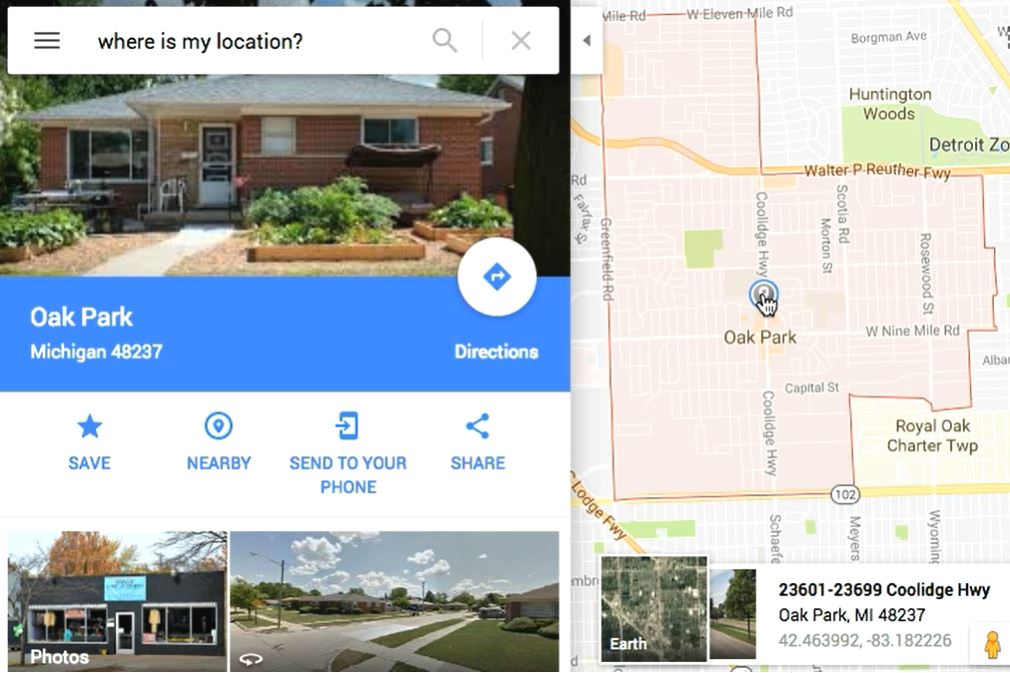
So, on my desktop, I can actually look and see where does Google think that I am? And Google thinks I’m in Oak Park here. And in fact, if I click right here in the center, if I just, like, click on a spot, it even gives me the latitude and the longitude, which can be useful. I just kind of chose the very center of that space. But Google is sort of generally saying it thinks I’m somewhere there now. That’s actually not where I’m located. I am quite close to that area, but I’m actually more over here on the side just outside of what the screen can see. So Google does not always know where the searcher is but Google knows, to a very close proximity where a searcher is. And having your business’s address near the location where the searcher is searching is an important ranking factor. Now that’s something you can’t always even determine, but it’s something to know that that’s important.
Also, having the business address in the city where prospects are searching. Sometimes you’ll hear local SEO people say, “In the city of search.” So if you’re in a major metropolitan area, many of the people searching for the type of business are going to be actually in the city itself. And so then having your business address in the city itself is going to be an advantage. If you’re in a suburb, it may be difficult for you to rank for searches related to that particular city, either because the searcher is in the city or maybe because the searcher has included the major city name in their search. You know, I live in a suburb of Detroit, it may be hard for me, you know, if I have a business, you know, in a suburb of Detroit, it might be hard for me to rank for searches that include the word actually “Detroit” in the search in competition with businesses that are located in the city itself. So that’s something else to consider.
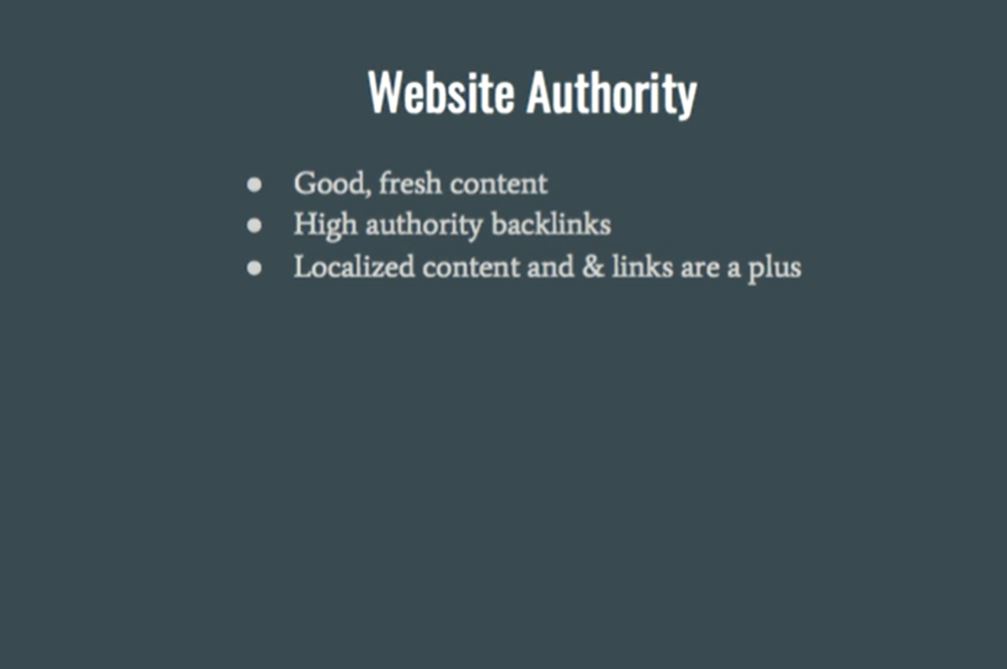
Even though we’re talking about local results, the authority of the website associated with that local listing is a major factor in how it ranks. And there are several things you want to bear in mind with that. It’s good to have good fresh content on a site. In general, lots of pages indexed with lots of unique content, not just repeated information over and over, or content grabbed from various other sources that are already out there on the web, but actually unique content written on many pages on your site. In general, that is a sign to Google that it’s a high-quality site. And so having good fresh content is a ranking factor for your website and also for your local listing. When you’re researching the competition and considering the content on the sites that are you are competing with, the number of pages indexed is one way to know it’s basically how many pages does Google know that this site has?

And so, if you’re researching the competition, this is the Easy Local Cash Software, and we have a pages indexed column where we find out how many pages does Google know about on the website that’s associated with this listing. And so you can look down and see different websites, and how many pages Google knows is on those sites. It doesn’t tell you for sure that they have good fresh content, but it can be a sign. The number of pages that Google has indexed for them, if they have tons and tons of pages, that’s a sign at least that maybe they have a site that has a lot of content on it.
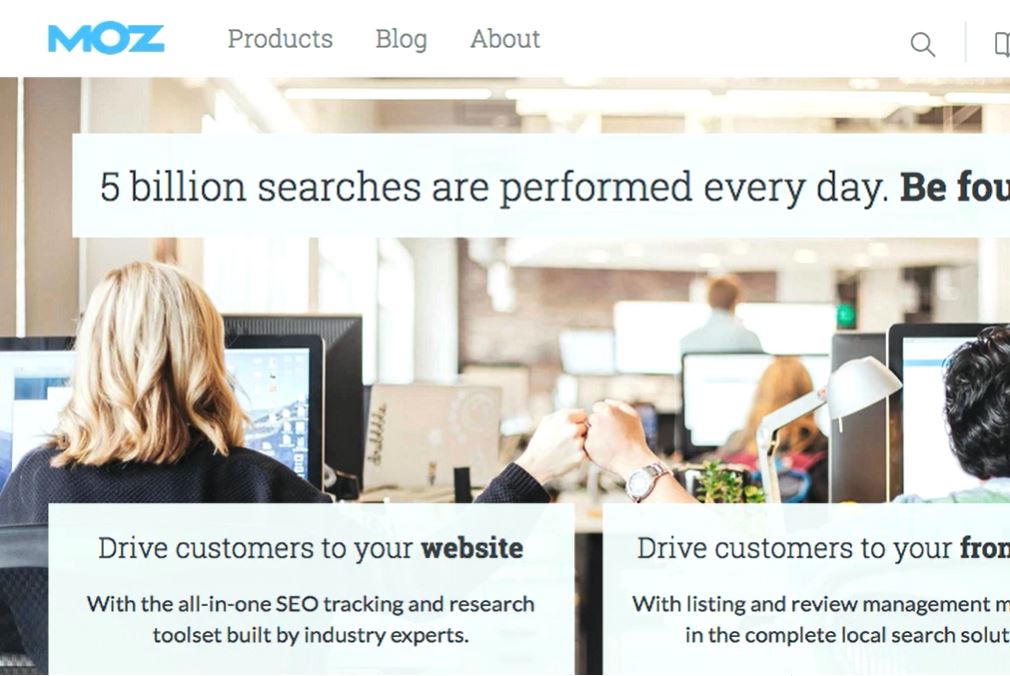
High authority backlinks are sort of what I think most SEOs really know and consider to be a major authority factor or ranking factor is having many backlinks, having backlinks from high authority websites. The Easy Local Cash Software also has some link metrics for websites associated with the local listing. And so that’s one way for you to do a quick evaluation of the competition for a given keyword phrase and a certain location. You can look at the links there. External equity links are links coming from off of the website that do follow links. All links are just all the links to the homepage, They could be on that site itself. They could be on other sites. The reason we have these two numbers here is because we get our link data from Moz. Moz is an SEO company. They provide a lot of SEO tools, and we use their API to get those numbers. Majestic is another really good tool for getting backlinks. And also other signs of authority for website, if you’re wanting to check out various competition, Majestic is another really good one. Ahrefs is another tool that you can use to determine backlinks to a website and also it has sort of enough some authority metrics that you can look at as well. That’s another good tool for researching the competition and comparing that to your own site.
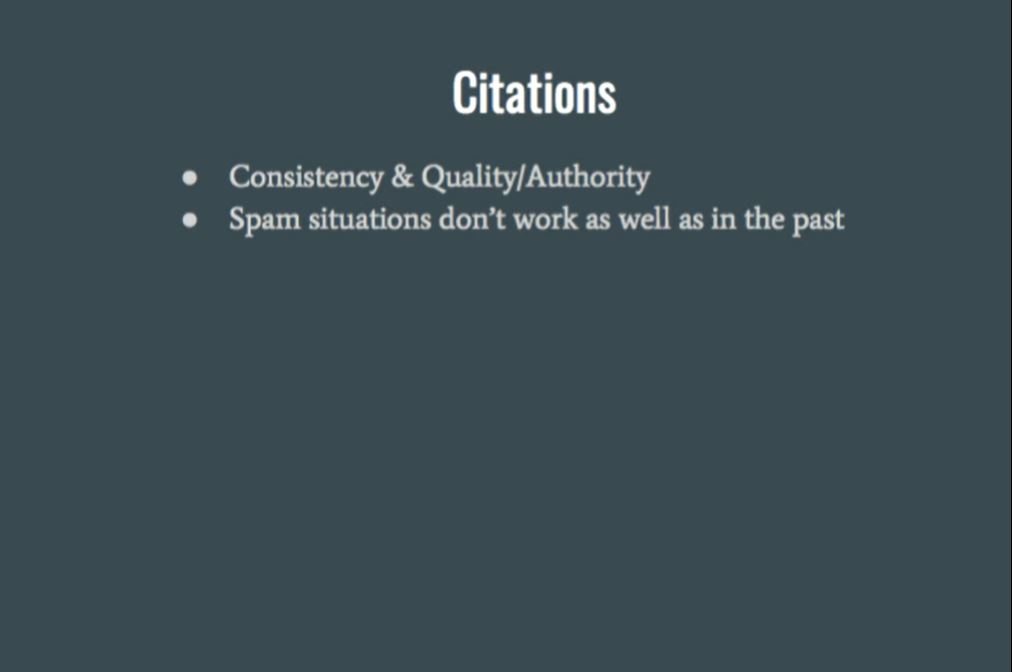
Localized content and links. Basically, I’m putting this in there as a plus. Having a good authoritative website is the most important thing, but if the content on your site is local to the business area, that’s going to be positive. And also, if you’re getting links that are from, for example, from the Chamber of Commerce, or other specifically local, say, local newspapers, those kinds of things which are sort of demonstratively local links, those are going to be also pluses in terms of ranking specifically for local. Citations are anywhere that your business name, address, and phone number, or maybe some subset of those three things, name, address, and phone number are appearing on the web. You can think of citations almost as the backlinks of the local world when it comes to that local listing itself, that having lots of consistent citations out there that Google knows about, that’s going to demonstrate to Google that your local listing is trustworthy. And a lot of times what we’re talking about in ranking these local listings is a trust factor..
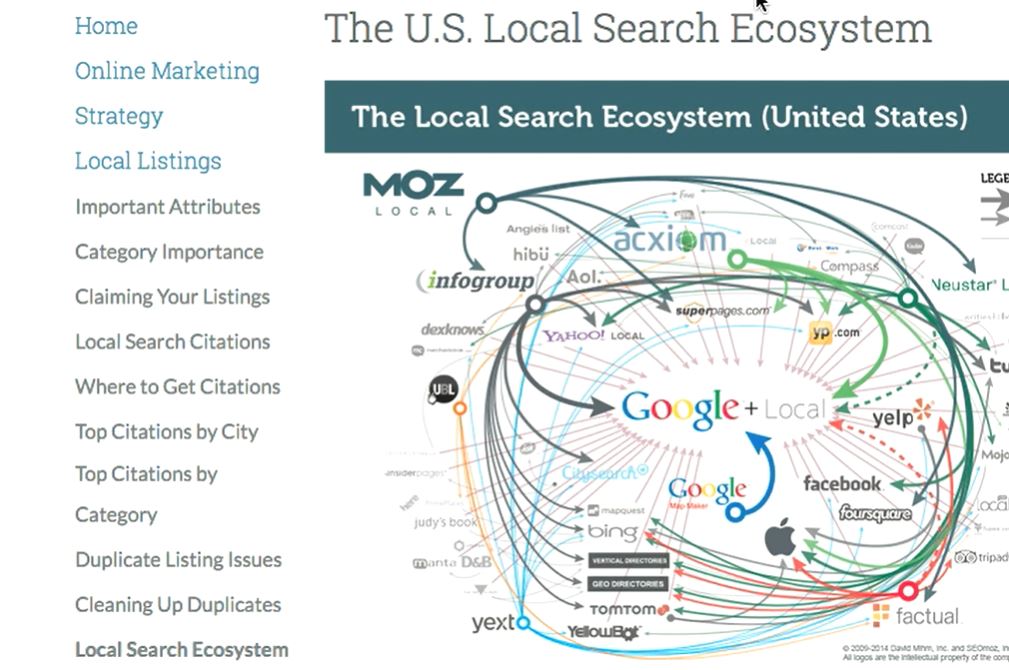
So, consistency and quality/authority are really what we want to focus on when it comes to citations. There was a time when you could just, you know, blast a bunch of different directories and even just sort of blog links or blog posts that have your name, address, and phone number in there. And those would all count. We were really thinking about quantity of citations. But now you really want to think about having consistent citations on some specific, very important sort of data providers. This is a graphic that Moz provides that is like an ecosystem about what different players all factor into who’s getting data when we’re thinking about citations? And I would say, this is for the United States. And I would say the three you want to really think about and make sure that you have a good solid business information on are Infogroup, Acxiom, and Neustar or Neustar Localeze. Localeze is what it used to be called.
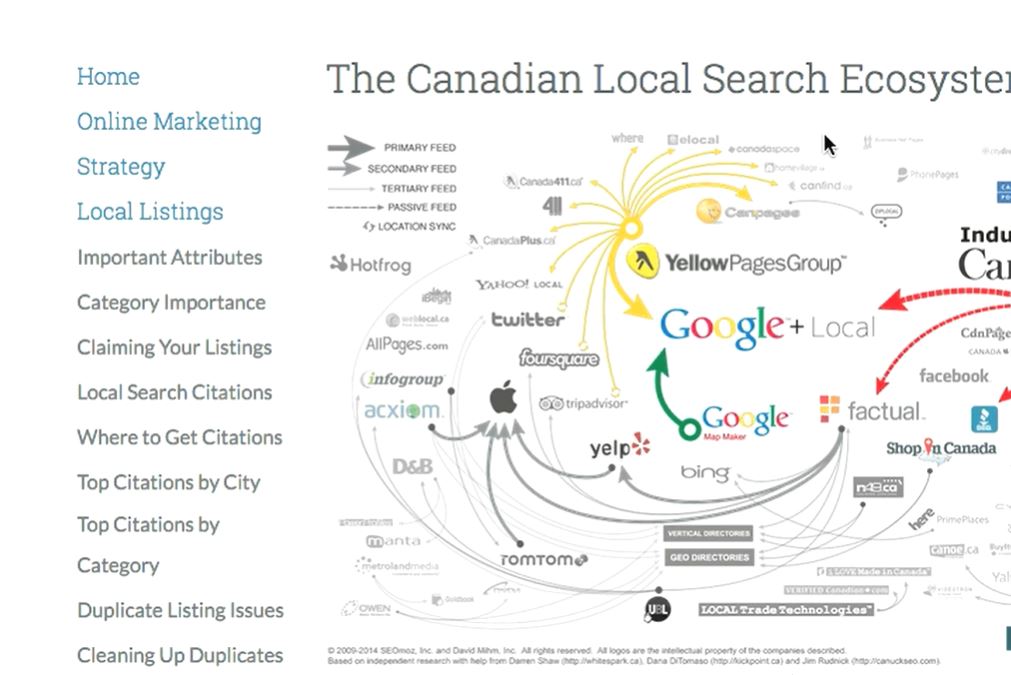
Submitting to those three, they’re going to kind of disseminate your data out to many different sources. And you’re going to make sure that you have really consistent data. So in the United States, those three are really the big players you want to consider. The Canadian Ecosystem is slightly different. Moz has a version for that, which you could look at as well, that might be helpful if you’re in Canada. The United Kingdom has a slightly different version as well. So depending on where you are, I believe there are actually even a couple of other countries as well that Moz has done specific local search ecosystem information for. But the bottom line is that you want to make sure that you have very consistent citations across these really sort of high quality, high authority sort of data providers. From there, you do want to be doing other citation building as well, but you want to make sure that as far as core ranking, you want to be talking about making sure it’s consistent on those really core data providers. Spam citations are just not…they don’t work as well as they did in the past. There are situations in which it will still work, but not as well as in the past.
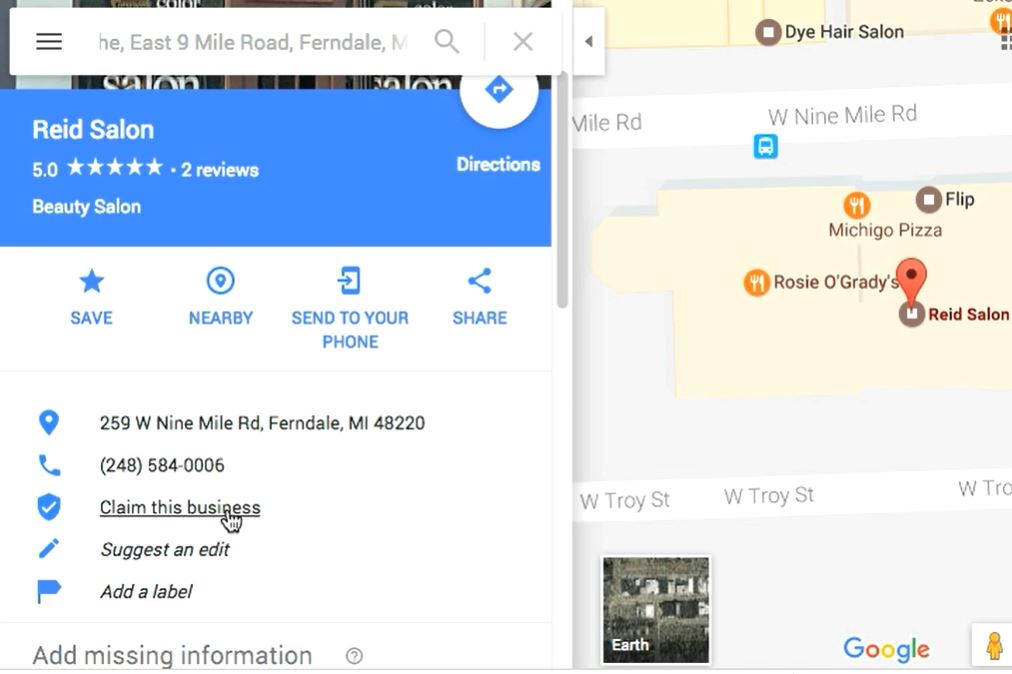
Having a claimed listing. This is a simple one. If you are doing any kind of work on your listing, it’s going to be claimed. This is an example of a listing that is not claimed. Reid Salon, I just looked them up because they’re in the city where I live. And you can see it actually has a link to claim this business. That means that this listing is not claimed and these listings will rank but claiming the business is assigned to Google again of trust that that’s a valid listing. And so you want to make sure your listing is claimed. It’s going to be one of the first things you’re going to do anyway.
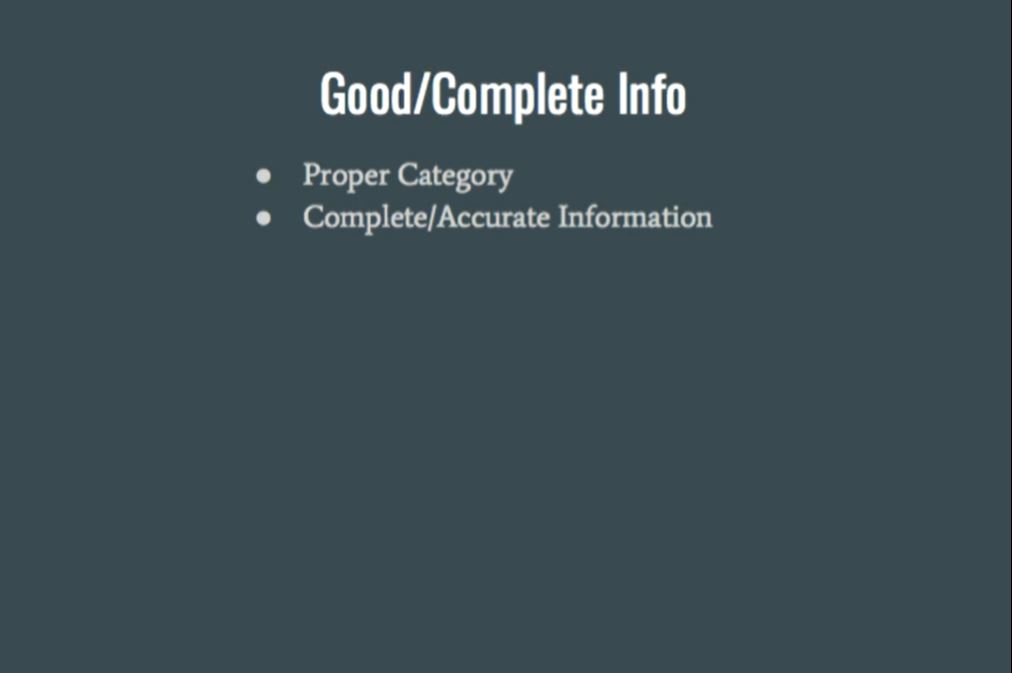
You want to have good and complete information for your listing. In particular, I want to mention that you need to have a proper category. You can see that this is my local listing and you can see that I’m categorized as website designer. You want to make sure that that category that you have for whatever listing, your listing is that that is correct. That’s a major factor in where you’re going to show up. And I would also say, try to make sure you’re categorized well on other citation providers or data providers as well. And then also, you want to make sure you have really good info. So you want to make sure all these… Anywhere that when you are in there, this is Google My Business dashboard, and anywhere that Google allows you to enter information, I recommend that you enter the information. So that means hours, website, phone, address, category, photos, all of these things are going to be really helpful. They even have sometimes you can add special hours. And, for example, like holiday hours or things like that, that’s going to be a factor to add those things in as much as you can. You want to make sure that that data is complete and that it’s accurate.
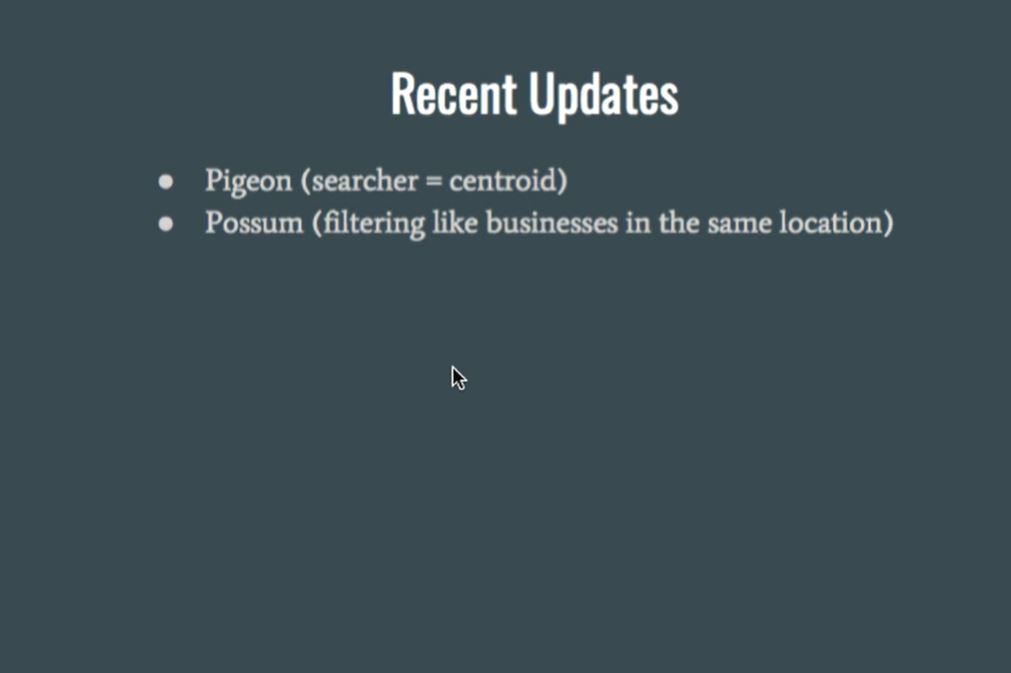
Some recent updates I want to talk about to sort of some of the core ways that this works before I hand this back over to Chad, Pigeon is an update that is not actually that recent, but I mentioned it because Pigeon was the first situation in which we began to see the searcher becoming the center of where Google provided listings. I mentioned that having your business address close to where the searcher actually is searching or where Google thinks the searcher is searching from, is important. That’s a factor that has grown more and more as Google has gotten better and better at determining your searcher’s location. And so I mention Pigeon not because it’s that recent, but because that searcher being the center of what we call the centroid, which is where Google sees…the center of where Google is going to provide results around, that signal has only grown over time.
Possum is a more recent update. And the primary thing that Possum has done is that if you have similar or like businesses in the same location, either at the same address or even in the same building, Google has begun filtering out, basically, having those businesses compete against one another. So, for example, if there’s a dentist’s office, but each dentist in the office is listed separately, it used to be that you could sort of dominate the Local Pack with a bunch of dentists from the same office. But now, only one of the dentists from that office building is going to show up. And so they’re sort of…sometimes it can put professionals in the same business in competition with each other for local space. So that’s something to bear in mind when you’re thinking about how you’re splitting up listings at a business, if you’re going to list professional separately, that’s something you want to bear in mind is that Google has now really begun filtering out, just showing one, the strongest listing from a specific location or a specific building. So that’s an important one too. So those are just a couple of recent updates that are worth talking about, as well as details on kind of the core ranking factors you want to be thinking about in getting your listing set up. And so now I want to hand this back over to Chad to talk about some things that are happening right now that we’ve been doing and been finding some success with.
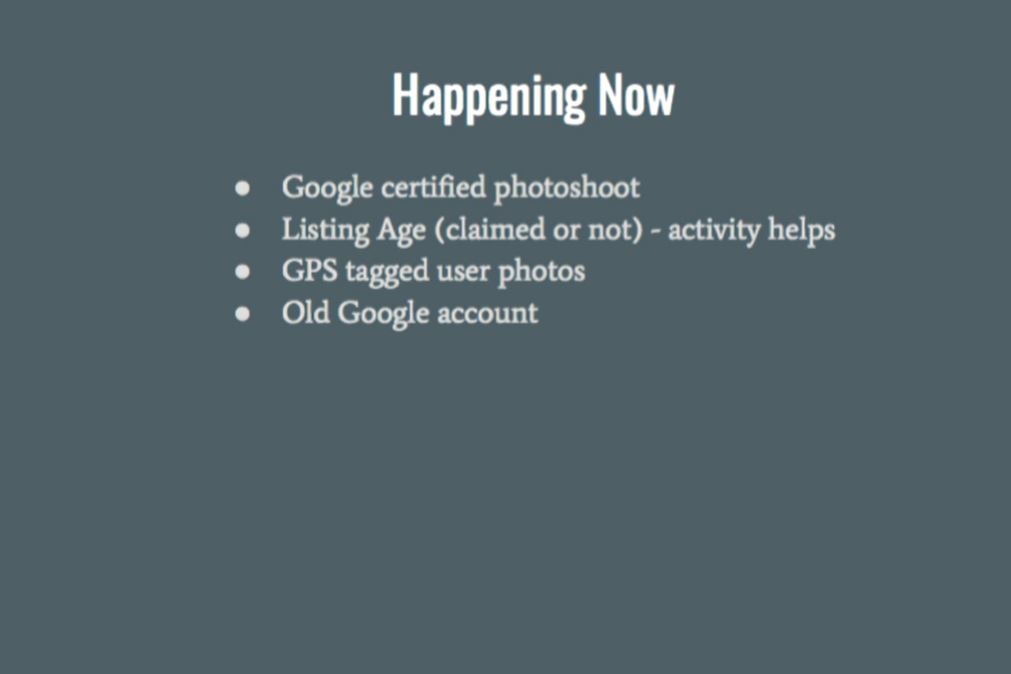
Chad: All right, thanks for that, Seth. I want to talk about a couple of things that we’ve been doing that are more kind of cutting edge stuff or newer things that we found that are either ranking shortcuts or if you’re in a highly competitive situation, you can get an edge up on your competition with some of these things. Some of the things I’m going to mention here might not be part of, like, the main factors, like, your best… They also might not work in all situations. But I want to share with you guys because some of the stuff we found had a lot of success with using some of these techniques.
The first one is a Google certified photoshoot. And this is…if you haven’t heard of this, there’s something called the Google trusted photographer program. And that’s when actually a photographer who’s actually been certified by Google themselves to take photos of businesses, you actually hire them to come out to your business location and take photos from the entryway, all the way inside, and all around the inside of the facility. And I think a lot of businesses don’t do this because they think it’s maybe just for restaurants or just for, you know, a store where you have a lot of foot traffic and people would want to see the inside. And you might think, “Oh, well, this has nothing to do with my business. You know, the inside of my business has nothing to do with the customer experience, so I’m not going to bother with that.” Or you might think that about your clients. But a Google certified photoshoot is a huge trust factor to Google. And we’ve seen it be a very powerful ranking factor that is ranked really fast. And you can get a Google certified photo photographer to come out and do a photoshoot, even if you have a business that’s not like a restaurant, or a theater, or something where people would want to see the inside. It really doesn’t matter whether your customers want to see the inside. We’re not talking about a conversion situation here, we’re talking about a ranking situation.
And if Google sees that you’ve had a Google certified photographer come out and take photos of the inside of your business, it’s a huge trust factor for them and you are going to find your stuff ranking a lot better with that, even if maybe some of the other core algorithms stuff, maybe you’re behind your competitors. Encourage if you have that or if your client has some cash to spend on that, you can get it done for just a few hundred bucks. They’ll come out, they’ll take a photo, they’ll upload it, and it will show up that photo…those photos will show up as sort of almost like a street view looking photoshoot where the searcher can click around inside the photo and travel around inside your facility through the photo. They stitch them together kind of like Street View.
And you can do it no matter what. If you just have a boring office or if you have, you know, something where maybe you don’t have a lot of foot traffic coming in of customers, it really doesn’t matter because it’s going to help you rank. And for just a few hundred bucks, if you’re in a highly competitive space, I encourage you to do that. We’ve seen listings jump to the top or even get a one box, which is when you do a search in Google, you’re the only local business that shows up, we’ve seen that happen just from getting a Google certified photoshoot. So get out there and do that if you’ve got a few hundred bucks to spend on it. I just literally went to Google Maps and searched Google photographer, Google certified typographer, a couple of guys came up. I called them, they came out. It was really simple, really easy to do, and it’s not that expensive.
The second thing that I wanted to mention is listing age. And listing age [inaudible 00:26:37] not a lot of people talk about, but sometimes it’s good to know about this, especially if you can’t figure out why you’re not ranking. Maybe you’ve got your competitors beat in all the major factors. Your website’s more powerful. You’ve got better citations. You’ve got more consistent citations. Your location is better and you can’t figure out why you’re not ranking. A lot of times it can be an age issue, that just waiting a few weeks or a month or so can give you the advantage you’re looking for just because Google’s waiting to see your listing. We’re waiting to see it age. Also, you know, you might even be frustrated because you might have a competitor that has an unclaimed listing, and you’re like “Man, my listings claimed, it’s legit, everything’s set up, why can’t I beat this guy?” Well, I had a situation where there was an unclaimed listing, it was out there, the business wasn’t even open anymore. It was a picture of the guy’s house. And I still was not able to beat it because this listing had years of age, and the one I was working on was relatively new. And so, if you’re in a situation like that, age could be a factor.
Also, you might want to read between the lines, but there are grayish and blackhat type of techniques you can use that allow you to take advantage of the age factor. I’m not going to get into that in this article. But if you read between the lines and get creative there, there’s a lot of things you can do there to help you utilize age to help you to rank. And again, it can be claimed or not. Sometimes just age can enable an unclaimed listing to rank over a claim listing. Again, hope you guys are reading between the lines there. There’s a lot you can do even with an unclaimed listing to get it to rank, just if you let it age.
Okay. And along with age there’s also the age of the Google account itself. So if you’re setting up brand new listings, it can be valuable to use an aged Google account. If you have like a Gmail that’s been laying around, a Gmail account that’s been laying around, maybe you haven’t really used it, but, you know, set it up in 2012 and then you never used it, it can be a great opportunity for you to set up a Google listing on that. You can even buy aged gmails if you’re setting up a lot of listings, and it can give you an advantage. Google wants to see that you’ve been in their universe for a while, and that helps them to trust the listing and the activity if they see an old Google account.
Third thing or fourth thing is GPS tagged user photos. More and more, the content that’s on Google Maps is coming from people’s mobile devices. And a lot is coming from phones that have GPS enabled. And if GPS is enabled and you take a photo, the GPS coordinates of where that photo was taken are actually in the data of that photo. You know, it’s usually listed in the underlying data of the photo along with, you know, resolution of the photo, and how large the photo is, and the photo format, and things like that. A lot of that, photos have the ability to record GPS data and attention to this, it’s easy to read this data. And so, it helps legitimize your listing if you have photos taken with GPS data included.
So, in other words, say if you’re trying to add some photos to your listing, it’s much better for you to have an employee go out there with their phone and snap shots of the front or the inside or whatever with the GPS data, it’s much better to do that than to get a much nicer photo taken that doesn’t have any GPS data included in the photo. This can help a lot. It can especially help a lot if you’re trying to legitimize a listing that Google’s questioning or you’re wondering, you know, if they’re going to believe that this listing is actually there. Getting GPS data into the photos and getting those photos loaded is a huge help. Even better if you can actually do it through the Maps app itself. So, in other words, instead of going in your mobile device straight to your camera and taking your photo that way, open the Maps app first and navigate through the Maps app to where it says, add a photo or snap a photo, take a photo through the Maps app, it’ll [inaudible 00:31:45], but then you’ve got a, you know, triangulation of data there [inaudible 00:31:53] at this time, they opened up their Maps app, they clicked add a photo at this time, then, a few seconds later, a photo came from their camera of their mobile device into the Maps app that matches the GPS coordinates and everything lines up is a huge trust factor as well.
So, again, these are things that we’ve been experimenting with that have made a big difference, especially in grayish hat type applications where we’ve got a lot of listings out there, generation type listings, and stuff like that. You can use these things to your advantage. And again, it’s much better to have a solid listing with all the standard best practice things that we just listed in this article. But sometimes, depending on the type of listing you’re setting, you’re able to do everything that the regular algorithm is looking for is you can use some of these other tactics to give yourself a leg up on your position.
